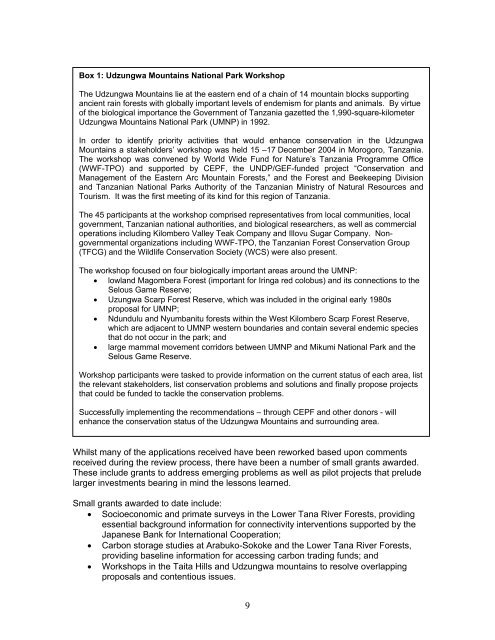Eastern Arc Mountains and Coastal Forests of Tanzania and Kenya ...
Eastern Arc Mountains and Coastal Forests of Tanzania and Kenya ...
Eastern Arc Mountains and Coastal Forests of Tanzania and Kenya ...
You also want an ePaper? Increase the reach of your titles
YUMPU automatically turns print PDFs into web optimized ePapers that Google loves.
Box 1: Udzungwa <strong>Mountains</strong> National Park WorkshopThe Udzungwa <strong>Mountains</strong> lie at the eastern end <strong>of</strong> a chain <strong>of</strong> 14 mountain blocks supportingancient rain forests with globally important levels <strong>of</strong> endemism for plants <strong>and</strong> animals. By virtue<strong>of</strong> the biological importance the Government <strong>of</strong> <strong>Tanzania</strong> gazetted the 1,990-square-kilometerUdzungwa <strong>Mountains</strong> National Park (UMNP) in 1992.In order to identify priority activities that would enhance conservation in the Udzungwa<strong>Mountains</strong> a stakeholders’ workshop was held 15 –17 December 2004 in Morogoro, <strong>Tanzania</strong>.The workshop was convened by World Wide Fund for Nature’s <strong>Tanzania</strong> Programme Office(WWF-TPO) <strong>and</strong> supported by CEPF, the UNDP/GEF-funded project “Conservation <strong>and</strong>Management <strong>of</strong> the <strong>Eastern</strong> <strong>Arc</strong> Mountain <strong>Forests</strong>,” <strong>and</strong> the Forest <strong>and</strong> Beekeeping Division<strong>and</strong> <strong>Tanzania</strong>n National Parks Authority <strong>of</strong> the <strong>Tanzania</strong>n Ministry <strong>of</strong> Natural Resources <strong>and</strong>Tourism. It was the first meeting <strong>of</strong> its kind for this region <strong>of</strong> <strong>Tanzania</strong>.The 45 participants at the workshop comprised representatives from local communities, localgovernment, <strong>Tanzania</strong>n national authorities, <strong>and</strong> biological researchers, as well as commercialoperations including Kilombero Valley Teak Company <strong>and</strong> Illovu Sugar Company. Nongovernmentalorganizations including WWF-TPO, the <strong>Tanzania</strong>n Forest Conservation Group(TFCG) <strong>and</strong> the Wildlife Conservation Society (WCS) were also present.The workshop focused on four biologically important areas around the UMNP:• lowl<strong>and</strong> Magombera Forest (important for Iringa red colobus) <strong>and</strong> its connections to theSelous Game Reserve;• Uzungwa Scarp Forest Reserve, which was included in the original early 1980sproposal for UMNP;• Ndundulu <strong>and</strong> Nyumbanitu forests within the West Kilombero Scarp Forest Reserve,which are adjacent to UMNP western boundaries <strong>and</strong> contain several endemic speciesthat do not occur in the park; <strong>and</strong>• large mammal movement corridors between UMNP <strong>and</strong> Mikumi National Park <strong>and</strong> theSelous Game Reserve.Workshop participants were tasked to provide information on the current status <strong>of</strong> each area, listthe relevant stakeholders, list conservation problems <strong>and</strong> solutions <strong>and</strong> finally propose projectsthat could be funded to tackle the conservation problems.Successfully implementing the recommendations – through CEPF <strong>and</strong> other donors - willenhance the conservation status <strong>of</strong> the Udzungwa <strong>Mountains</strong> <strong>and</strong> surrounding area.Whilst many <strong>of</strong> the applications received have been reworked based upon commentsreceived during the review process, there have been a number <strong>of</strong> small grants awarded.These include grants to address emerging problems as well as pilot projects that preludelarger investments bearing in mind the lessons learned.Small grants awarded to date include:• Socioeconomic <strong>and</strong> primate surveys in the Lower Tana River <strong>Forests</strong>, providingessential background information for connectivity interventions supported by theJapanese Bank for International Cooperation;• Carbon storage studies at Arabuko-Sokoke <strong>and</strong> the Lower Tana River <strong>Forests</strong>,providing baseline information for accessing carbon trading funds; <strong>and</strong>• Workshops in the Taita Hills <strong>and</strong> Udzungwa mountains to resolve overlappingproposals <strong>and</strong> contentious issues.9
















